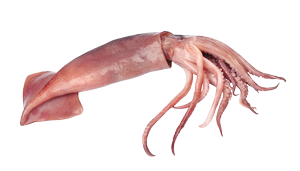
SQUID
Often seen on menus under the Italian name “Calamari”.
Squids and octopuses are actually mollusks and more closely related to mussels than shellfish.
Fish facts
Squid, with ten arms, often have more tender flesh than their eight-armed octopus relatives.
The thin flesh is best cooked rapidly at a high temperature. For octopus, the reverse is true (in both cases a medium cooking time produces a result reminiscent of rubber).
How to cook squid
The body – the “head” – must be gutted of intestines and the small, thin, flexible skeleton. Place one cut under the eyes – feel with your fingers where it is soft – so that you end up with a circle with tentacles. The “beak" where the tentacles meet should be removed.
Larger squid have a thin membrane that you can also remove under cold, running water.
Grill calamari on a hot griddle.
Its long shape makes squid perfect for fillings. Most of the Mediterranean dishes contain rice and/or breadcrumbs, olive oil, garlic, onion and flat leaf parsley. Smoked bacon and mincemeat are used too.
Small calamari are cooked more quickly and are more tender but remember that they will shrink further during cooking. They can fall down between the rungs if you cook them on a griddle with wide gaps.
The classic
Calamares a la Romana, deep fried squid rings. In Spain they are served with only lemon and salt. In the US, you find them with a selection of dips, in Mexico with strong chili sauces, in Turkey and Greece with each country’s respective version of tzatziki.
Conservation status:
Vulnerable in some fishing waters. Look for MSC labelling.








